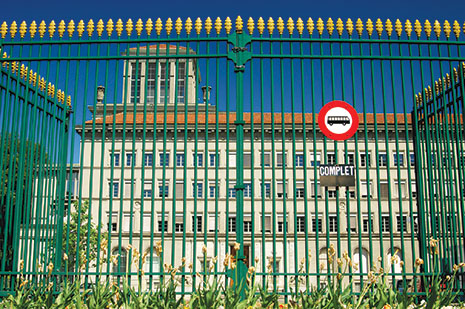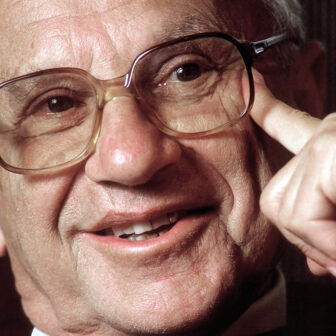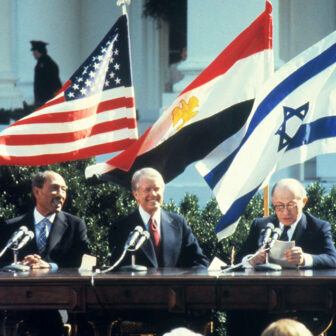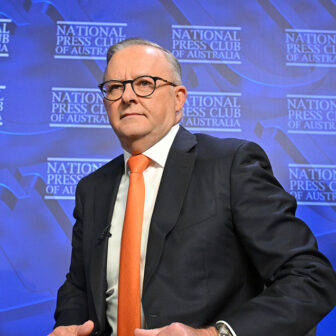It didn’t look like it at the time, but 1995, the year the World Trade Organization started its work, may have been the summit of American power. The old threat of communism had been crushed; the more recent fear of Japan had passed. In the summer, the web browser Netscape made its initial public offering and the internet boom began. The following year, Steve Jobs returned to Apple. Californian counterculture grabbed hold of commerce and reconstructed its commanding heights. Ideas were everywhere; money was cheap. Many spoke of a “New Economy.”
The Asian economic crisis came and went. The long boom in the West went back to booming, apparently confirming the durability of the economic model underpinning the WTO. In 2000, Bob Woodward published his biography of US Federal Reserve chairman Alan Greenspan, Maestro: Greenspan’s Fed and the American Boom. The reviews were still coming out when the Twin Towers fell and the soldiers set off for the Middle East.
Trade negotiators headed there too. Amid the tension and uncertainty of the days after the September 11 attacks, the US Trade Representative declared that the long-planned ministerial meeting in Qatar – the meeting that would launch the Doha Round of trade talks – must go ahead. “Let there be no misunderstanding,” he said. “The United States will continue to advance the values that define this nation – openness, opportunity, democracy and compassion. Trade reinforces those values, serving as an engine of growth and a source of hope for workers and families in the United States and the world.”
Even before the attacks these were crucial talks. The last WTO ministerial meeting in Seattle in 1999 had been suspended because of street protests. This time around, China and Taiwan (officially Chinese Taipei) were admitted to membership of the WTO and trade ministers said they were “determined, particularly in the light of the global economic slowdown, to maintain the process of reform and liberalisation of trade policies.” A work program was laid out, and a deadline – “not later than 1 January 2005” – was set for new agreements.
They didn’t make it. In 2008, as the negotiations continued, the Economist dubbed them “The Doha round… and round… and round.” Meanwhile, the day-to-day work of the WTO continued. The implementation of WTO obligations was monitored; member states’ trade policies were reviewed; periodic reports about trade barriers were published. Countries requested consultations with each other and notified disputes under the existing rules, panels were appointed to settle them, decisions were announced, sanctions were sometimes imposed.
Canada complained about Korean restrictions on beef imports and European restrictions on seal product imports. The Europeans disputed the Philippines’ taxes on distilled spirits. El Salvador, Honduras, Guatemala and Costa Rica complained about the Dominican Republic’s safeguard measures on imports of polypropylene bags and tubular fabrics. The United States contested Chinese measures affecting raw materials exports; the Chinese contested American measures affecting tyre imports.
The WTO was busy. Plans were developed to “renovate, densify and enlarge” its headquarters, the Centre William Rappard on Lake Geneva, funded by a donation and loan from the Swiss Confederation. Due to be finished by the end of 2012, the new building will combine “sobriety, modernity and efficiency,” housing 300 staff, a new library partly open to the public, a new restaurant and an underground car park.
Late last year, another WTO ministerial meeting took place in Geneva. Russia joined, the last big economy to do so. Still there was no resolution of the Doha Round. As the members of the General Council headed out of Geneva for their summer breaks at the end of July this year, director-general Pascal Lamy told them, “Those of you who believe that, as time passes, inexorably, the Round might lose all its remaining steam may be right, whether we like it or not.”
More progress is reported to have been occurring in Melbourne, Dallas, San Diego and Leesburg, Virginia, where the last four rounds of negotiations for another trade agreement – the Trans-Pacific Partnership Agreement, or TPPA – have been held this year. Round 14, in Leesburg, was in early September. The negotiations have attracted media attention when protesters have rallied outside the meetings or when sections of the negotiating texts have been leaked. A draft of the intellectual property chapter leaked in February 2011, a US proposal about access to medicines in March this year, and a draft of the investment chapter in June.
The TPPA originated in a 2005 deal between Chile, Singapore, New Zealand and Brunei. When the United States expressed interest in joining that group, other countries got interested as well, even though they already had bilateral agreements with some of the partners. The first round of negotiations towards what became known as the TPPA was held in Melbourne in early 2009 with eight participants. Peru and Vietnam joined the United States, the original four countries, and the host, Australia. Malaysia was admitted soon after, and in June this year Canada and Mexico joined in. These eleven are now considering a formal expression of interest from Japan, the world’s third-largest economy, which means things are getting very interesting indeed.
The group of countries that met in Melbourne in 2009 was an odd crew. Those that didn’t already have bilateral free trade agreements with the United States saw the TPPA as the best way to get one. But for the United States, these were tiny markets and the likely gains from trading more freely with them were marginal. What made the group attractive to US trade negotiators was the fact that it might be willing to do the kind of trade deal America now wanted. This could serve as a model and perhaps a building block for other negotiations in the Asia-Pacific region and around the world. The TPPA was “the most credible pathway to broader Asia-Pacific regional economic integration,” according to the US Trade Representative, and became a central economic expression of President Obama’s “pivot” to Asia.
All the statements about the TPPA’s aims highlight three buzz phrases. It is to be a “high-quality agreement,” a “twenty-first-century agreement” and a “living agreement.”
A high-quality agreement means it should cover all sectors of economic activity, including sensitive ones like agriculture and textiles, and require liberalisation with minimal exceptions.
A twenty-first-century agreement – “an ambitious, next-generation trade agreement” – means it should not only aim to limit restrictions like tariffs, import quotas and export subsidies that have impeded cross-border trade in the past, but also target the trade restrictions that matter most now and in the future. These include the “behind-the-border” restrictions that obstruct the creation and flow of intermediate and completed goods and services through the complex, multi-country production and supply chains that are now common. It also means the agreement must deal with digital economy, electronic commerce and green technology issues and be useful to the small and medium-sized enterprises that are now responsible for so many of the new jobs created.
A living agreement means one that can be updated to cover new issues and expanded to accommodate new members. But new members will need to join an agreement struck by its founding members, and there are important members of the Asia-Pacific region that are playing no part: South Korea, India and China.
Until the 1980s, most trade negotiations were multilateral. Regional or bilateral agreements like the European Common Market, later the European Union, and the Australia–New Zealand Closer Economic Relations Agreement, were unusual. During the 1990s, these “preferential” trade agreements multiplied.
As if already anticipating that the formation of the WTO might represent multilateralism’s high-water mark, negotiators got busy in smaller groups. Freer trade with neighbours and major trading partners could deliver significant economic benefits, and the deals might actually get done. According to WTO director-general Pascal Lamy, the average WTO member is now a party to thirteen separate “preferential” trade agreements, and there are around 400 in total.
The shift to preferential trading agreements like the TPPA has tested Australia’s historical commitment to multilateralism, and the TPPA negotiating process is severely stretching the current federal government’s strategies and philosophies. In its April 2011 trade policy statement, “Trading Our Way to More Jobs and Prosperity,” the Gillard government reaffirmed its view that a “multilateral trade deal offers the greatest prospective benefits.” It said it would continue pushing for an “ambitious, comprehensive outcome of the Doha Round that liberalises trade in agriculture, manufacturing and services,” but conceded that “during the present recovery there is little obvious appetite among a number of major economies for further trade liberalisation…”
In these circumstances, the government said it is interested in bilateral and regional deals, but only if they are “truly liberalising.” It is not interested in “collecting trophies for the national mantelpiece: empty vessels engraved with the words Free Trade Agreement that formalise and validate existing trade restrictions.” It also says it doesn’t want to muddle up trade policy and foreign policy. “Entering into bilateral and regional trade deals for the geo-political purpose of excluding others can be fraught with danger,” it said, and the “tough process of negotiating trade deals” is not necessarily the best recipe for closer political friendship.
Labor watched the rapid negotiation of the Australia–US Free Trade Agreement from the opposition benches after 9/11. It criticised the lack of transparency and the Howard government’s failure to provide a credible analysis of the economic benefits of the final deal, as opposed to the aspirations declared at the outset. Two changes to the negotiated outcomes – protecting the Pharmaceutical Benefits Scheme and local program quotas for commercial broadcasters – were forced when the implementing legislation was introduced into parliament.
The transparency of the TPPA negotiations is stretching Labor’s philosophy now. The government’s April 2011 trade policy statement says the public should be kept “closely informed of the nature and progress of negotiations.” As stages in the deal-making process are completed, “relevant information should be posted on government websites.” Transparency can certainly be “time-consuming and give anti-trade interests partial information to use against the government before the public has had the benefit of considering the fully-completed deal,” but “negotiations shrouded in secrecy enable opponents to speculate inaccurately about the content of agreements.”
Bringing transparency to the TPPA negotiations has proved difficult. Departmental officials have worked hard to consult with interested parties but the negotiating texts are not being made public and the updates posted after each negotiating round are bland. This makes it particularly tough to scrutinise what is happening on novel issues where the negotiations may go beyond precedents in other agreements, or where the relationships between different parts of a big, complex agreement are critical to its practical impact. Before the Leesburg meeting, 134 members of the United States Congress wrote to the US Trade Representative to try to get “broader and deeper” consultations with relevant Congressional committees, access to the draft TPPA text and observer status at the meeting.
Consistent with the nature of a single negotiation where “everything is on the table” and “nothing is agreed until everything is agreed,” the government has been reluctant to rule any measures in or out of the TPPA. In general, it says it “will not support provisions in trade agreements that constrain our ability to regulate legitimately on social, environmental or other similar important public policy matters.” Specifically, it won’t accept provisions that “limit its capacity to put health warnings or plain packaging requirements on tobacco products or its ability to continue the Pharmaceutical Benefits Scheme.”
Significantly, the government says it opposes “investor–state dispute resolution procedures… that would confer greater legal rights on foreign businesses than those available to domestic businesses.” These procedures could give investors from member states new rights to take action directly against national governments, rather than through their own governments.
Pharmaceutical companies, for example, like investor–state dispute resolution processes because they provide another way to challenge legislation and regulation that they believe exaggerate health risks of new drugs. Philip Morris is using the investor–state dispute resolution process in the 1993 Australia–Hong Kong Agreement for the Promotion and Protection of Investments to challenge the plain packaging legislation that Australia’s High Court declared valid in August.
These kinds of provisions are included in many of the United States’ bilateral free trade agreements, though not the one with Australia. They are clearly on the US agenda for the TPPA and are included in the US Trade Representative’s November 2011 outline of the provisions it says will be in the investment chapter.
Despite its conditions, the government’s April 2011 policy statement said the TPPA was its “highest regional trade negotiation priority.” It is also “one possible pathway” to the government’s long-term goal, a Free Trade Area of the Asia–Pacific spanning all APEC economies – not the only one, but “currently the most-advanced.”
In early September 2012, Australia’s trade minister Craig Emerson and the trade ministers of China, Japan, India, Korea, New Zealand and the ten ASEAN countries met in Cambodia and “laid the foundations” for another: a Regional Comprehensive Economic Partnership. Australia already has a free-trade agreement with ASEAN; this ASEAN-plus-six deal would include eight of Australia’s top ten trading partners. Ministers will meet again in November, when negotiations are expected to be formally launched. According to the minister’s media release, this “will constitute the early delivery of work being conducted for the Gillard Government’s White Paper on Australia in the Asian Century.”
So Australia is negotiating a TPPA with the United States but not China, India and Korea, and a Regional Comprehensive Economic Partnership with China, India and Korea but not the United States. Emerson didn’t call the Regional Comprehensive Economic Partnership just “another possible pathway”; it was, he said, “the perfect vehicle for advancing Australia’s interests in the Asian Century.”
In the round of negotiations that created the WTO, three countries or blocs – Japan, the United States and the European Union – called most of the shots. Among the three, it was the United States that negotiators called the “G1.” All are now in different kinds of economic crisis. Japan’s is the longest-running, Europe’s seems the deepest, but it is America’s that is the most unsettling for the multilateral trading system, because it was America, more than anywhere else, that provided its intellectual and political bedrock.
Younger members of the WTO are not so deeply in thrall to the mid-1990s economic policy consensus. Some were less surprised than Alan Greenspan to find its ideological footings unsure, but even some who believed it most profoundly were shaken by the roles that deregulated banks and capital flows played in the Asian meltdown in 1997 and later global financial crisis.
When the WTO’s predecessor, the GATT, was founded in the late 1940s, it had twenty-three members. As it got bigger, the work got harder and the negotiating rounds got longer. Sixty-two countries participated in the three-year Kennedy Round in the early 1960s; 102 in the six-year Tokyo Round in the 1970s. For the Uruguay Round, starting in 1986 and ending in 1994, there were 123 countries. The World Trade Organization they formed now has 157 members and an eleven-year-old Doha Round with no end in sight.
The WTO’s challenge is not just the number and size of the new economies that now are part of it, but the different models of economic progress they have brought. They may have all joined the same organisation and agreed, at least over time, to play by the same rules, but they did not all come with equal passion for its mission to keep liberalising all trade measures for all-comers. Some joined to change it, and change it they have.
WTO headquarters, the Centre William Rappard, is named after a Swiss diplomat and academic, “one of the most articulate and influential voices against collectivism and nationalism… an international man in an age of nationalism.” It was built for the International Labour Office in the 1920s, when the League of Nations was trying to keep the warriors of 1914 at peace. The WTO’s predecessor, the GATT, moved in in 1977.
The United States has always had a complex relationship with multilateralism. It didn’t join the League but hosted the conference in July 1944 at Bretton Woods that laid out the elements of postwar economic order. An International Trade Organisation was one of the three new global economic institutions proposed. The other two, the International Monetary Fund and the organisation that became the World Bank, were both established; their trade counterpart was not. The United States supported the idea strongly at first, determined to turn back the economic protectionism of the 1930s, but enthusiasm waned after a Republican Congress was elected in 1946. Democrat president Harry S. Truman allowed the necessary domestic legislation to lapse in 1950.
In 2012, a presidential election year, the American political system is again a crucial factor in whatever might be done in global and regional trade negotiations. The Democrat platform boasts that “this administration has doubled the rate of trade cases brought against China by the last administration.” On 17 September, China launched a WTO dispute against the United States about “Countervailing and Anti-dumping Measures on Certain Products from China” and the United States started one against China over “Certain Measures Affecting the Automobile and Automobile-Parts Industries.”
Passionate free traders worry about the role the United States is playing in global trade at the moment. Columbia University professor of economics and law Jagdish Bhagwati thinks that “the US has abandoned any pretence of leadership on world trade.” The TPPA, Bhagwati says, “is a political response to China’s new aggressiveness, built therefore in a spirit of confrontation and containment, not of cooperation.” It “is being sold in the US to a compliant media and unsuspecting public as evidence of American leadership on trade. But the opposite is true… The TPP is a testament to the ability of US industrial lobbies, Congress, and presidents to obfuscate public policy.”
This means that the kind of trade deal the United States now wants might be a long way from the kind that other TPPA partners want, or even that it would once have wanted itself.
And the kind of trade deal China wants? Australia has been exploring that since 2005, when a joint feasibility study was completed. It concluded that “there would be significant economic benefits for both Australia and China through the negotiation of [a bilateral free trade agreement].” But a deal, signed and sealed? According to the Department of Foreign Affairs and Trade’s website, “The negotiations are complex, covering an array of issues…”
This is what it means to be a middle power in the Asia-Pacific region. •




